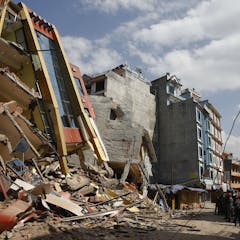
Artículos sobre Nepal earthquake 2015
Mostrando 1 - 20 de 39 artículos

During the COVID-19 crisis, some medical students at school in Pokhara, Nepal, went to rural Himalayan villages to teach about the virus. Others go home to challenge social inequities.

Bhaktapur suffered 300 deaths, 2,000 wounded and over 30,000 houses damaged in the 2015 earthquake. Heritage restoration has become crucial to community recovery.

Nepal’s past dealing with multiple disasters, including the aftermath of its civil war and the massive earthquake of 2015 may have helped the country prepare for the current COVID-19 crisis.

With the enhanced capabilities of today’s robots and drones, recent examples from China and Thailand and ongoing research show that they have the potential to help us navigate disasters.

Nepal’s capital city was devastated by the 2015 earthquake, but rebuilding heritage sites has been fraught with difficulties.

It’s understandable to want to shield children from the impacts of disasters. But research suggests that they should be given a voice in disaster planning and a role in reducing the risks.

Pregnant women and new mothers who feel totally powerless are taking their own lives in increasing numbers in Nepal. More mental health training for local midwives is needed.

Reconstruction progress in Nepal has been painfully slow. Building code compliance and better urban planning are a must – but inequitable access to resources undermines recovery.

Two years after the second earthquake rocked Nepal in 2015, the recovery efforts have been stalled by political instability and money mismanagement.

Over 8,500 were killed in the 2015 Nepal earthquake, so how is the country coping?

When disaster strikes, more people than ever are turning to social media to find out if they’re in danger. But Australian emergency services need to work together more to learn what works to save lives.

Hayley Saul and Emma Waterton were in the Langtang valley in Nepal when the massive earthquake hit. Dallas Rogers spoke to Hayley and Emma about their subsequent rescue and the everyday Nepalese hero.

New research shows the earthquake that struck central Nepal in April this year was only a partial rupture of the fault line, meaning another strong quake could be due in future.

When disaster strikes, billions of dollars are spent on food and supplies, with little accounting of whether relief groups bought the right things or what impact they had.

While some operators have prematurely suggested it’s safe for tourists to return, Nepal’s recovery from the earthquake has barely begun. In the longer term, though, tourism will be vital to this process.

Almost 24,000 classrooms were damaged or destroyed in Nepal’s April earthquake.

The magnitude 7.3 earthquake that hit Nepal this week should be classed as an aftershock rather than a second earthquake.

Politics in Nepal will hinder relief and recovery efforts following the earthquake and its aftershocks. But look at it the other way around. Could the disaster help to resolve political problems?

What led to the second major earthquake to hit Nepal in less than a month?

Following the earthquake in 2010, people flocked to Haiti to “rescue” orphaned and lost children. The problem that has since emerged is that many of the “orphans” placed in orphanages and sent for adoption, were not orphaned at all.
